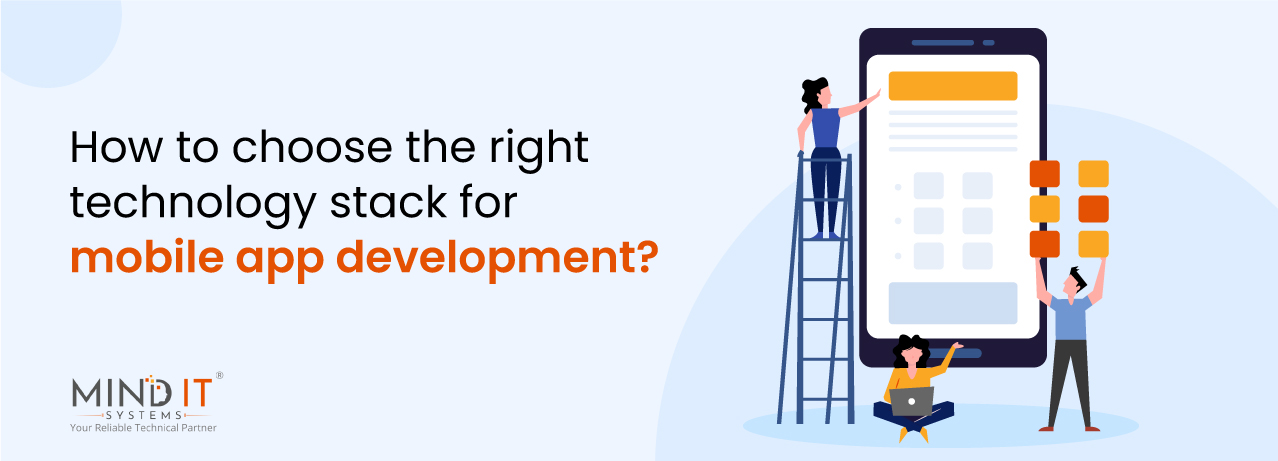
How to choose the right technology stack for mobile app development?
Introduction
Choosing the best tech stack for mobile apps is like picking the right ingredients for a delicious meal. Just as the right recipe can make a dish stand out, the technology stack you choose can greatly affect your app’s performance, user satisfaction, and overall success. This decision is crucial for decision makers because it will directly impact your budget, timeline, and users’ experience.
The mobile application market is projected to reach $614.40 billion by 2026, highlighting the immense potential for your future app. To capitalize on this growth, selecting the right mobile technology stack for your app development is imperative. Doing so will help you reach your prospective customers and deliver a high-quality, engaging user experience. A well-chosen tech stack ensures that your app runs smoothly, is scalable for future updates, and meets the demands of your target audience, ultimately setting the foundation for your app’s success.
This blog will guide you through the vital factors to consider when deciding on your mobile app development frameworks, programming languages, backend technology, and more. It will assist you to make smart choices that set your app up for success!
So, let’s get started.
This Blog Page Covers
The Technology Stack Explained
A technology stack combines various technologies, programming languages, frameworks, and tools used to build and run an application. This stack usually consists of front-end (client-side) technologies, back-end (server-side) technologies, and databases for mobile app development.
- Frontend Technologies: These create the app’s user interface and user experience. Your choices here affect how users interact with your application, making it essential to prioritize usability and aesthetic appeal.
- Backend Technologies: This includes the server, database, and application logic. A robust backend is crucial for managing data and ensuring smooth communication between the server and the client-side app.
- Databases: Selecting the right database technology is essential for efficient data storage, retrieval, and management. Your choice will depend on the scale of your app and the types of data you need to manage.
Not sure which technology stack is right for your app? Let our experts guide you in making the best choice!
Importance of Picking the Best Tech Stack for Mobile App Development
Choosing the best technology stack for mobile app development is imperative for several reasons. It directly impacts the performance, scalability, and sustainability of your app. A carefully selected tech stack ensures that your app can handle user demands, remain secure, and scale as your business grows.
Additionally, the right tech stack aligns with your app’s specific purpose, budget, and time constraints. It provides faster development, reduces future maintenance costs, and improves user satisfaction. Conversely, choosing an ill-suited stack can lead to higher development costs, poor performance, and difficulty in scaling or maintaining the app.
Making the right decision in the early stages of your app development project, including considerations for building a mobile app, prevents potential roadblocks, ensuring that your app delivers the best possible experience to your users while meeting your business objectives.
Key Considerations for Choosing the Best Tech Stack for Mobile Apps
1. Project Requirements and Goals
Before selecting any technology, clarify your app’s goals and requirements. Consider questions like:
- What problem does your app solve?
- Who is your target audience?
- What features are essential for your app?
Understanding these factors will help you determine the necessary technologies to achieve your goals efficiently. Check if your business needs a mobile app by assessing market demands and evaluating how an app could enhance customer engagement and streamline services.
2. Native vs. Cross-Platform Development
One of the critical decisions is choosing between native and cross-platform development.
- Native Development: This approach involves creating apps specifically for one platform, such as iOS or Android. Native apps offer superior performance, access to device features, and a better user experience. However, they require separate codebases, leading to higher development costs.
- Cross-Platform Development: Cross-platform frameworks, like React Native or Flutter, allow developers to write code once and deploy it on multiple platforms. This approach can significantly reduce development time and costs but may sacrifice some performance and access to native features.
Deciding between these two options should align with your business strategy, budget, and the user experience you aim to deliver.
3. Mobile App Development Frameworks
Opting for the right mobile app development frameworks is vital for ensuring efficient development and long-term maintainability. Here are some popular frameworks:
- React Native: Known for its flexibility and performance, React Native allows for building apps with a native feel using JavaScript. It’s ideal for businesses looking to reduce development time without compromising on quality.
- Flutter: Developed by Google, Flutter is a UI toolkit that aids the rapid development of natively compiled applications. Its unique widget-based architecture allows for a beautiful and highly customizable user interface.
- Xamarin: This Microsoft framework is great for C# developers and allows for building cross-platform apps. It provides native performance experience and is well-suited for enterprise applications.
Picking the right framework depends on your team’s expertise, app’s requirements, and the desired user experience. Consider outsourcing your app development to a reputable offshore software development company. They can guide you in selecting the best technology stack and assist in the development process, ensuring a successful app launch.
4. Choosing Programming Languages for Mobile Apps
The programming language you pick plays a crucial role in your app’s development. Here are some common options based on the chosen approach:
1. For Native Development:
- Swift: Swift is the preferred language for iOS app development, and it is known for its performance and safety.
- Kotlin: The modern language for Android development, Kotlin offers concise syntax and improved safety features compared to Java.
2. For Cross-Platform Development:
- JavaScript: The primary language for frameworks like React Native.
- Dart: The programming language used in Flutter, designed for high-performance applications.
Selecting a language your team is comfortable with can lead to faster development and a more successful project outcome.
5. Mobile App Backend Technology Options
The mobile app backend technology options are just as critical as the front end. Your choice affects how efficiently your app processes data and performs overall. Some popular backend technologies include:
- Node.js: Known for its non-blocking I/O model, Node.js allows developers to easily build scalable network applications, making it an excellent choice for real-time applications.
- Django: This Python framework is perfect for building robust and secure web applications. Its built-in features accelerate development time and provide a solid foundation for your app.
- Ruby on Rails: Popular for its speed and simplicity, it is a great option for startups and small businesses that want to market their apps quickly.
When selecting your backend technology, consider factors such as scalability, performance, and your app’s specific needs.
Wrapping it Up
Selecting the best tech stack for mobile applications is a crucial part of the app development journey. By assessing your project’s unique requirements, choosing between native and cross-platform solutions, and thoughtfully deciding on the most suitable frameworks, programming languages, and backend technologies, you’re paving the way for your app’s success.
With a well-thought-out tech stack, your business can enhance user experience, streamline development processes, and ensure scalability. Remember, the right choices today will pay off in the long run, leading to a successful mobile app that meets your business goals and delights your users.
Share this post
About the Author

Sujoy Roy
(Head – Digital Marketing)
From my teenage time, I had a quench to solve problems and loved leadership. Starting my career in relation management, ignited my passion for managing people. While managing I realized technology needs to be incorporated to keep pace with the changing world & do my work efficiently.

